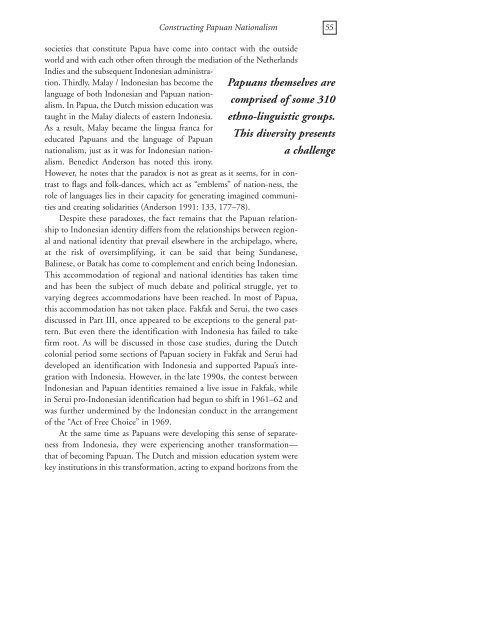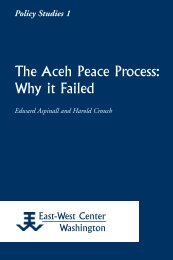Constructing Papuan Nationalism: History, Ethnicity ... - ScholarSpace
Constructing Papuan Nationalism: History, Ethnicity ... - ScholarSpace
Constructing Papuan Nationalism: History, Ethnicity ... - ScholarSpace
- No tags were found...
Create successful ePaper yourself
Turn your PDF publications into a flip-book with our unique Google optimized e-Paper software.
<strong>Constructing</strong> <strong>Papuan</strong> <strong>Nationalism</strong> 55societies that constitute Papua have come into contact with the outsideworld and with each other often through the mediation of the NetherlandsIndies and the subsequent Indonesian administration.Thirdly, Malay / Indonesian has become thelanguage of both Indonesian and <strong>Papuan</strong> nationalism.In Papua, the Dutch mission education wastaught in the Malay dialects of eastern Indonesia.As a result, Malay became the lingua franca foreducated <strong>Papuan</strong>s and the language of <strong>Papuan</strong>nationalism, just as it was for Indonesian nationalism.Benedict Anderson has noted this irony.However, he notes that the paradox is not as great as it seems, for in contrastto flags and folk-dances, which act as “emblems” of nation-ness, therole of languages lies in their capacity for generating imagined communitiesand creating solidarities (Anderson 1991: 133, 177–78).Despite these paradoxes, the fact remains that the <strong>Papuan</strong> relationshipto Indonesian identity differs from the relationships between regionaland national identity that prevail elsewhere in the archipelago, where,at the risk of oversimplifying, it can be said that being Sundanese,Balinese, or Batak has come to complement and enrich being Indonesian.This accommodation of regional and national identities has taken timeand has been the subject of much debate and political struggle, yet tovarying degrees accommodations have been reached. In most of Papua,this accommodation has not taken place. Fakfak and Serui, the two casesdiscussed in Part III, once appeared to be exceptions to the general pattern.But even there the identification with Indonesia has failed to takefirm root. As will be discussed in those case studies, during the Dutchcolonial period some sections of <strong>Papuan</strong> society in Fakfak and Serui haddeveloped an identification with Indonesia and supported Papua’s integrationwith Indonesia. However, in the late 1990s, the contest betweenIndonesian and <strong>Papuan</strong> identities remained a live issue in Fakfak, whilein Serui pro-Indonesian identification had begun to shift in 1961–62 andwas further undermined by the Indonesian conduct in the arrangementof the “Act of Free Choice” in 1969.At the same time as <strong>Papuan</strong>s were developing this sense of separatenessfrom Indonesia, they were experiencing another transformation—that of becoming <strong>Papuan</strong>. The Dutch and mission education system werekey institutions in this transformation, acting to expand horizons from the<strong>Papuan</strong>s themselves arecomprised of some 310ethno-linguistic groups.This diversity presentsa challenge
















